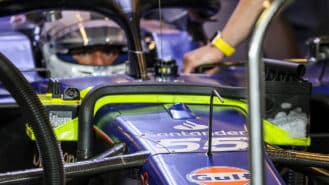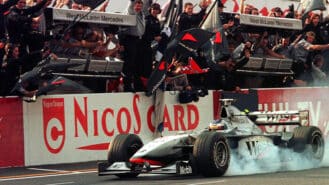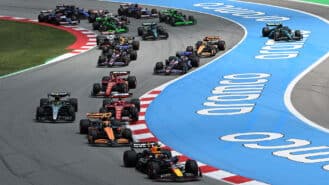They insist that they didn’t offer him more money and that he did not seek priority status. The other ‘they’, meanwhile, insist that they fought hard to keep him.
So why did Lewis Hamilton eschew Macca for Merc?
Was it to protect and promote his brand?
Or was it because of the swingeing 2014 engine regs, for which Mercedes-Benz appears best placed?
Or was it because of McLaren’s impending customer status?

No, no, no. It’s much simpler than that: it’s because he had to. Even though any Red Bull and Ferrari aspirations – most drivers’ Plans A and B – were thwarted by that nice Mark Webber and the ruthless Fernando Alonso, his need to leave McLaren had become too urgent for him to deny. His Woking environment, the glasshouse that had nurtured his talent since he was a teenager, had become a glazed cage. Rather than his staring in wonder from its protective within, he now felt stared at – and judged, often unfairly – from the tantalising wide without.
McLaren is a fantastic team with a rich and successful history, present and probably future, but the fact that M-B, a huge industrial combine with a somewhat severe and stolid image, can be seen by Hamilton and his handlers as freer and easier tells you all you need to know about why fastidious McLaren is not every driver’s trophy full of champagne. That nurturing arm around the shoulder can become a bit ‘creepy uncle’.
Even though the team’s atmosphere has lightened with Martin Whitmarsh’s hand upon its tiller, it could not keep pace with its star pupil’s transformation. Hamilton, so fresh-faced that I’m jolted whenever I double-check his age, is a changed man (with perhaps some growing up still to do) from the beaming kid that strung together the greatest rookie season of all F1 time. Then, everything was a bonus, a fresh challenge, and the world was his oyster. Since, the pearl has gradually turned to grit.
As he became increasingly hip so his surroundings appeared increasingly square. The earrings, the on-off superstar ‘squeeze’, the showbiz Svengali – not bad things in themselves – are hardly McLaren fundamentals. And those terse chip-chip-chippy car-to-pit (off) messages and that twitchy tweet from Spa were indicators that this bird was ready to fly the nest.

At 27, Hamilton is approaching his driving pomp. So, better a change of circumstance than a mid-career crisis. He will never recapture entirely the spirit of that first season – probably doesn’t want to or need to – but it wouldn’t do him any harm to claw some of it back. Regaining that smile – win or lose with Mercedes – will be as important as the results themselves.
That is to say very important. Just because he ‘had’ to do it doesn’t make the move automatically the correct decision.
Team swaps by world champions carry extra expectation and pressure. Twelve reigning champs, from Juan Fangio in 1952 to Jenson Button in 2010, have relocated upon completion, be it by choice, coercion or circumstance. All bar the IndyCar-bound Nigel Mansell of 1993 remained within the Grand Prix arena.
Some proved unmitigated disasters: Fangio to Maserati in 1952 – he broke his neck at Monza! – Alberto Ascari to Lancia in 1954 and Damon Hill to Arrows in 1997. Denny Hulme’s move to McLaren in 1968 was filled with honour and honest endeavour over the next seven seasons; Niki Lauda’s to Brabham 10 years later was bad but understandable. Some were good albeit with reservations: Fangio to Ferrari in 1956, Prost to Ferrari in 1990 and Fernando Alonso to McLaren in 2007. And some were (almost) inspired: Mansell’s reputation was burnished by his first term in America’s oval office, as was Jenson Button’s when he joined McLaren.
The latter, all smiles and occasional sensational wins, did not wrench the team from Hamilton’s grasp but rather launched a charm offensive that has finally seen him wrest control – for perhaps a season or two.

Which leaves Hamilton, admittedly now an outside bet for this year’s world title albeit through no fault of his own, exposed in the harsh contrasting light emitted by Fangio and Michael Schumacher, the man he is to replace.
Fangio, who reigned with quiet charisma, had the knack of being in the right car at the right time. That’s how it seemed at least. More apposite is that he made his various situations work in the days when gear ratios and tyre pressures were the only quick-fix set-up tweaks available to a driver.
By 1951, the once-dominant svelte Alfetta was punch-drunk, bloated by a huge thirst for fuel, and Fangio just about clung on in the face of a Ferrari that was a mph match on double the mpg. His 1954 mid-season switch from Maserati to Mercedes-Benz is today viewed as a no-brainer, yet that is to ignore that the W196, a curious mix of new tech and old hat, was no sinecure; Ascari’s much-delayed Lancia D50 had more potential. In Ferrari’s more pragmatic form, some might say blacksmithed, the latter gave Fangio his fourth and least favourite world title: 1956. Juan was no fan of Enzo’s machinations or his macchina.
Best of all was his return to happy-go-lucky Maserati in 1957: its beautiful 250F, the epitome of the front-engined GP car, those 150mph downhill power-slides at Rouen, his remorseless hunt of Ferrari’s Mike Hawthorn and Pete Collins at the Nürburgring, and a fifth world title, aged 46. Helmet tipped back with thumb, puffed-out cheeks blackened by brake dust, engine fumes and road dirt, he knew he could do no more. Homeric.

Schumacher, who reigned with a relentless behind-the-scenes blue-collar work ethic, cannot equal such romance, but his decision to join Ferrari in 1996 after two consecutive title years with Benetton provides the SI unit of this blog’s topic: the schum.
He joined an outfit that had scored just two wins over the five previous seasons; Hamilton has signed for one with one in three. Schumacher united and energised his new team, pulled it and its various key suppliers tightly to him and held them there while he ragged them flat out on every lap – test, practice, qualifying and race – for 11 seasons.
By way of thanks Ferrari squeezed him – a man still wrestling with the fact that he doesn’t know what other roles he might play – out. The three seasons he missed as a result of the Scuderia’s chill-wind planning for the future – which made as much sense to me as does its abject failure to sign Sergio Pérez – might have obviated his need for the done-him-few-favours three he is soon to complete with Mercedes.
Hamilton has stated that he wants to become a multiple world champion. That way greatness beckons. It’s impossible to imagine him matching Schumacher’s 72 wins and five titles with Ferrari; he has the time – Schumacher was 27 when he rocked up at Maranello – but, I suspect, not the long-term focus: too many other interests, distractions and marketing opportunities. Don’t forget, Ayrton Senna was his hero, not Schumacher. But if he successfully unpicks Ross Brawn’s brain – and vice versa – there’s absolutely no reason why he can’t keep the earrings, etc while keeping his nose to the grindstone and foot to the carbon floor.
Yeah, a good, energising move this one – albeit with reservations.








